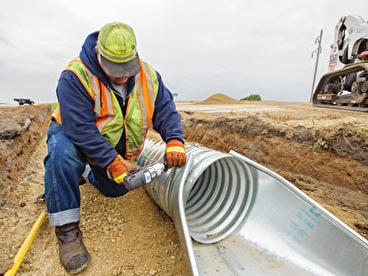Efficient Underbrush Clearing for Clean and Safe Land
Efficient Underbrush Clearing for Clean and Safe Land
Blog Article
Culvert Setup Facilitated: Step-by-Step Guide for Success
From selecting the appropriate culvert dimension to integrating correct drain steps, each step in the installment procedure plays a vital role in the capability and longevity of the culvert system. Stay tuned to uncover the vital actions and considerations that can make culvert setup a smooth and effective venture.
Picking the Right Culvert Dimension
Picking the suitable culvert size is important for guaranteeing effective water circulation and structural stability in culvert setup projects - Pad Construction. The dimension of the culvert directly influences the flow capability of water with the structure. A culvert that is also little can result in flooding and overflow, while one that is too large might lead to reduced water rate, potentially creating sediment accumulation and obstructions
To identify the best culvert dimension, elements such as the watershed area, height flow rates, and hydraulic efficiency requirement to be very carefully thought about. Calculations based upon these parameters aid in choosing a size that can sufficiently manage the expected water volume while lessening the risk of clogs and architectural failure.
It is vital to consult design standards and criteria to make sure that the picked culvert size fulfills the task needs and regional regulations (Pad Construction). By choosing the ideal culvert dimension, job managers can maximize water flow, protect against possible problems, and improve the total effectiveness and longevity of the culvert installation
Preparing the Installation Site
Effective culvert setup necessitates precise prep work of the installment site to guarantee ideal architectural support and functionality. Prior to commencing the installation process, it is crucial to remove the website of any kind of particles, greenery, or blockages that could impede the culvert's positioning.
Additionally, it is necessary to consider elements such as soil composition, groundwater levels, and environmental impacts when preparing the setup website. Performing a detailed site evaluation can help identify any type of possible challenges or threats that might affect the culvert's efficiency. By putting in the time to prepare the installment site properly, you can aid guarantee an effective culvert installment that fulfills structural requirements and ensures lasting capability.
Positioning the Culvert Appropriately

The quality at which the culvert is positioned is critical for keeping a correct incline for blog here water flow. A progressive incline aids avoid merging and advertises efficient drain. Additionally, the culvert ought to be oriented properly to ensure that the inlet and electrical outlet are in the correct locations. This positioning is essential for the culvert to function successfully in taking care of water circulation.
Backfilling and Condensing the Soil
Appropriate backfilling and compaction of the soil around the culvert is vital to make sure security and stop prospective problems in the future. As soon as the culvert is appropriately positioned, the following important step is to backfill the area around it with appropriate material. The backfill material should be devoid of rocks, particles, and natural issue to avoid damages to the culvert. It is suggested to utilize granular material such as sand or crushed rock for backfilling, as it supplies good drainage and compaction residential or commercial properties.
Compaction assists in minimizing the chances of negotiation and makes sure uniform assistance around the culvert. It is vital to small the dirt evenly on all sides of the culvert to keep its structural honesty.
Correct backfilling and compaction not just provide security to the culvert yet additionally help find this in stopping dirt erosion and keeping the longevity of the culvert system.
Ensuring Correct Water Drainage Assimilation
Integrating reliable drain options plays a critical function in the total capability and long life of culvert installments. Appropriate drain assimilation is vital for taking care of water flow, protecting against erosion, and ensuring the structural stability of the culvert system. To achieve this, it is crucial to design a comprehensive drainage plan that thinks about factors such as the quantity of water anticipated, the topography of the area, and the kind of dirt existing.

Furthermore, integrating functions like disintegration control steps, such as riprap or vegetation, can additionally improve the efficiency of the drain system. By thoroughly intending and executing these drainage solutions, culvert setups can operate successfully and hold up against the examination of time.
Conclusion
Finally, correct culvert installation is important for maintaining effective drainage systems. By choosing the ideal culvert size, preparing the installation site, putting the culvert properly, backfilling and condensing the soil, and making certain correct water drainage assimilation, success can be attained. Adhering to these actions will certainly assist make sure the long life and efficiency of the culvert, ultimately adding to the overall success of the drainage system.
Report this page